Belonging to Ardnamurchan Clan MacIain
The scattering of the Ardnamurchan MacIains which began early in the 17th century means that it is unusually difficult for its present members to establish their sense of belonging to the clan. Your situation is further complicated by there being two MacIain septs within Clan MacDonald, those of Ardnamurchan and Glencoe. While the Ardnamurchan MacIains are descended from the followers of Iain Sprangach, those of Glencoe are descended from Iain Fraoch MacDonald, who was Sprangach’s brother, Angus Og of Islay’s son.
We don’t believe that DNA tests help, particularly in the circumstances of the Ardnamurchan MacIains. While the MacIain clan is a sept of the much larger Clan Donald, it would always have been a mixed population. When Iain Sprangach took over the land after Bannockburn, he would have inherited the resident population left behind when the MacDougals fled. An even more mixed population would have arisen over the centuries from the geographical position of the peninsula of Ardnamurchan: it blocks the main sea route north-south along the west coast of Scotland. In days when travel by sea was far more important than by land, many people would have come to the peninsula and settled. What bound this disparate clan together was fealty to the clan chief.
The clan tartan is shown. As with all these things, we have to exercise some care: the modern concept of tartans didn’t come into being until late in the 18th century, by which time our MacIains were long scattered, but that did not prevent their descendants establishing the tartan and heraldry of the clan. The tartan of the Ardnamurchan MacIains is a simple but very beautiful one, well suited to the landscape of their home. Particularly in autumn, these are the colours of Ardnamurchan’s hills.
In heraldic terms, the arms of Ardnamurchan Clan MacIain are described as “Or, a lymphad, sails furled and oars in action, Sable, between in fess dexter an eagle, displayed, Gules, and sinister a buckle, of the last.”
‘Or’ means the background is gold. A ‘lymphad’ is an heraldic ship based on the Scottish berlinn, wikipedia entry here. The sails are ‘furled’ and the oars ‘in action’. ‘Sable’ means the lymphad is black. ‘Fess’ is a horizontal division across the shield, and the dexter means to the right, as seen by the carrier from behind, in which there’s an eagle ‘displayed’ – which means the wings are spread. The spreading has a significance it indicates the bearer’s role as protector. ‘Gules’ is red, and refers back to the eagle. ’Sinister’ is left, and that the buckle is ‘of the last’ means it has the same colour as the previous mentioned item, the eagle, i.e., ‘Gules’, red.
Two things stand out. The ship is a berlinn. While these were the main mode of passenger and freight transport up and down the Scottish west coast for generations, they were also the man-o’-war of the feuding clans. The power which Clan MacIain held in the Lordship of the Isles came, in large part, from their holding Mingary Castle, which dominated and controlled the northern entrance to the Sound of Mull. From the bays on either side of the castle, Port Ur to the east and Port na Spainteach to the west, MacIain fighting ships would have launched both to battle and to intercept passing merchantmen.
The bird on the left is an eagle. There are two types of eagle flying across Ardnamurchan, the golden and the far larger sea eagle. The sea eagle is Europe’s largest bird, so big it is sometimes described as a ‘flying barn door’. As well as a bird of myth and legend, it was the great predator of the Scottish skies, to the extent that, by 1916, it had been hunted to extinction. It has been reintroduced, and now once again soars across Ardnamurchan.
The badge of Clan MacIain is shown here. It features the heraldic ‘eagle displayed’ and the motto of Clan MacIain, “In Hope I Byde”. For a clan that has been scattered to the corners of the Earth, yet still has so many members who feel an intense loyalty to it, it’s a truly great motto.
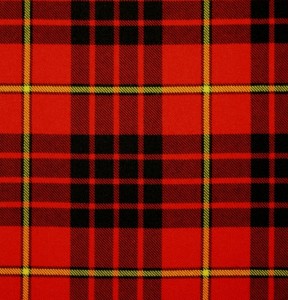
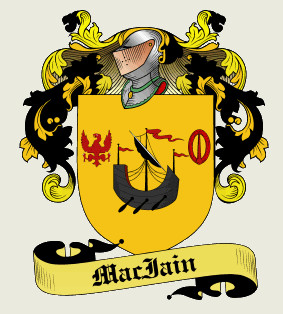
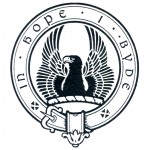
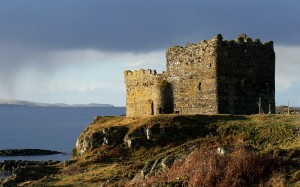

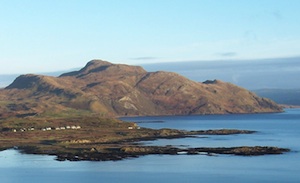

As pleased as I am to discover this website, I’m astounded that there appears to be a huge and fundamental omission from its information. Are you aware that the arms of Ardnamurchan Clan MacIain shown on the website were in fact granted to the Reverend William James McKain in 1905 by Lord Lyon King of Arms ? William claimed succession, as 20th Chief of Clan Iain of Arnamurchan, to John Sprangach and in 1913 was recognised by the Society of Clan Donald as Chief of Clan Iain of Ardnamurchan. My website http://www.mayhum.net/mckain.htm provides the necessary information. I’d be pleased to hear your views on this.
Hi there!
I was Florida Commissioner of Clan Donald USA for four years, and knew our National Geneologist James MacDonald very well. I have never heard this.Since the MacIains are a sept of Clan Donald, (Clan Donald of Ardnamurchan), and with all the trips that James MacDonald made back and forth to Skye in Scotland, (where the Clan Donald seat is) to meet with our High Chief, you’d think that he would have known something about this???
Nancy McKean Conner
From the Court of Lord Lyon “A clan cannot have a coat of arms. The Chief of a clan has his or her personal coat of arms but that belongs to the chief and cannot be used by anyone else.” https://www.courtofthelordlyon.scot/faqs.htm Thus, there can not be “arms of Ardnamurchan Clan MacIain”. The Court of Lord Lyon being Scotland’s Heraldic Authority, they are the final arbitrator of who the arms belong to.
The arms in dispute belonged to Alasdair MacIain, 13th Chief of MacIain of Ardnamurchan. Clan Donald vol 3 mentions the McKain family of Elgin and gives the Coat of Arms of Archibald McKain (I believe), which would belonged to Rev. McKain’s family. Mr. Mayhew’s point is that Rev. McKain presented evidence to Lord Lyon, submitted his personal Arms and was granted the Arms of Alasdair MacIain (as they were in the chiefly line originating with Iain Sprangach MacDonald) after being recognized as 20th Chief. Though this point is currently being disputed its is a strong argument. Rev. McKain’s line expired in 1959.
Hi
Our “coat of arms” was sanctioned by Robert the Bruce when he granted the Mac Iains the land and castle after the battle of Branockburn. Clan Donald itself had NO problem with that at all. It was awarded long before Lord Lyon was granting them!!!
Any information you have on the early McIans from Arnamuchan is appreciated. Next month I am going to Scotland and to Londonderry, Ireland. My descendent was Wm. McIan who fled Scotland for northern Ireland. Years later his line came to America as the first Scot Irish settlers.
Pam
Hi there,
interesting to stumble across this. Looks lovely! Can I ask, who operates the site, please? And, since you have my email address, now, I’d be very grateful to get in touch.
Many thanks
Chas
Hi there!
I’m Nancy McKean Conner, and will be visiting in April. I was Fla Commissioner for Clan Donald USA for 4 years in the 1990s, and was told by Clan Donald USAs geneologost at that time, Jim MacDonald, that I am MacDonald of Ardnamarchan. Looking SO forward to our trip! I love our tartan, and have a kilt skirt and sash made
In it.Is there a way to join with you as well? Thank you! Oh, my father ‘s family (MacKeans) came to the White Mountains of New Hampshire USA in 1705. Thomas McKean,a cousin of mine, signed the US Declaration of Independence. He was in Delaware at the time.
Sincerely
Nancy McKean Conner
I’m Alan McKean, and as traced i am a descendant from the MacIains of Ardnamurchan. I also have a wrap tartan of the same pattern from the late 1800’s that has been in my family’s possession for generations. I’m glad that I found this site. “In Hope I Byde” that it continues – keep up the wonderful work….. my son visited there in 2012 – before the restoration work began, but found the towns to be very friendly and the area beautiful…… Thanks!
Hi Alan!
Where are you from? My family is from New Hampshire, and immigrated to the US in 1705, from Ireland.We went from Argyllshire Scotland, to Northern Ireland ( according to our genealogical research this was in the early to mid 1600s,) and then to the US. Is your ancestor one of William’s sons ? There were 4 brothers that left Ireland together. We went to Ardnamurchan last year (4/17), and were escorted to Mingarry, etc. by Jon Haylett. I’d been corresponding with him for a while, and he met us there.What a wonderful historian he is! He had no doubt about my family coming from Ardnamurchan, and Clan Donald’s National Geneologist didn’t either! Jon said that there are only 2 spellings of the name, that make it a shoe in, and McKean is one of them. “Ean” of course is the ancient way of spelling ” Iain.” But you probably knew that!The other he said would be McIain of course! Hope I’ll get to meet you some time! Take it easy cousin! Sincerely Yours, Nancy McKean Conner
I am a descendent of William Mckean (other spellings) who was among the first Scot-Irish settlers in America. I visited Londonderry, NH. My direct descent from the immigrants was John McKean who died prior to his voyage, yet his wife and children did immigrate. I will be visiting Scotland in month. Unfortunately we will be traveling in a group and cannot go to the Mingary Castle. But any information about William (a conventor) who fled Scotland to Ireland and anything else about his ancestors would be helpful
Hi Pamela!
Were cousins! I’m a direct descendant of William McKean as well! According to Jon Haylett, a historian who lived there in the Ardnamurchan area, (we visited, and Jon gave us a tour) if your name is spelled ” McKean”, “Ean” being an ancient version of “Ian”, you ARE a MACIAIN. Our family branch, according to Jon, left Ardnamurchan in the early 1600s, when the Campbells took Mingary away. They went to Ireland.They stayed about 100yrs or so, and went to New England, New Hampshire to be exact. They arrived in 1705.This is ALL documented. Theres a cemetery in Landaff New Hampshire, Bath NH and check out Haverhill as well. They’re full of McKeans, including my direct Great Great Great Great Grandfather, Alexander McKean,who fought in the American Revolution. Cousin Thomas McKean signed the Declaration of Independence. Look under Delaware. Yup! Noble History! Take care Cuz!
Nancy McKean Conner
Hello. I also am a descendant of William. He was born in 1644, so the family may have been evicted from Ardnamurchan by that time. I am also descended from John, Samuel and Hugh. Hugh and his wife, Jane McCaw, immigrated from County Antrim to Pennsylvania about 1780. From there, my line moved to Ohio, Iowa, Saskatchewan and Washington State.I presently live in Central Washington. My father did not teach me much about family history but my aunt wrote a book that has a lot of accurate information.
Hello, I am Richard Paul MacKeen, descendant (either blood or adoption…still unknown) of Henry MacKeen (emigrated to St Louis area in late 1800’s) who lists Truro Nova Scocia as his birthplace. We think we are from one of the three sons of James McKean of Northern Ireland who’s father William MacKean was a descendant of the MacIian Chiefs of Ardnamurchan. James McKean had three sons James, Senr. (New England branch), John, Senr. (Nova Scotia branch) and William, Senr. (Pennsylvania branch). This information was from a paper written by John MacKeen of St Paul, MN in 1990 called “MacIan Chiefs”. We are very interested in how to get our tartan and in visiting Ardnamurchan. What a great web site!!!
Hi Richard!
I think you and I are distant cousins! My great, great, great, great (I think that’s the proper amount of greats!) Grandfather is James McKean, and my family is from the New Hampshire branch of the McKeans (MacIains) Weve got 3 cemeteries loaded with McKeans, including the grave of James McKean. Through Clan Donald, I met Kathy McKeen Shepard, who spent hours working on genealogy research. She connected herself to me, through the same family line that you are referring too, your line going to Pennsylvania. My family has had our genealogy done by other people in and out of the family, and it traces back the same every time. We’ve got our line going back from Argyllshire Scotland, to Northern Ireland, and finally to New Hampshire in 1705. Maybe I’ll get to meet you someday!
James McKean was the uncle of my descendent, Samuel, who parents were John (who died prior to immigration) and Janet Seafort who remarried after arriving in America. We will be traveling to Scotland and Londonderry, Ireland. Any info you have would be appreciated.
I know these ones. John is my 5th greatest grandpa
Do the McIain’s have a gathering each year or do they meet with Clan MacDonald? And when and where would either of these gatherings take place? My family, like yours moved from Scotland to Ireland for about 100 years and then to America before the revolution. I am so amazed that I have not seen this site before.
My name is Michael Mowery My family both sides came from Ohio . I live in Arizona . .My father was born to a 15yr. old unwed mother, Mowery was her maiden name .My Dads fathers name was McMurdy . I have learned the McMurdys were a sept family of the MacDonald Clan of Ardnamurchan .Dads great grandmother on his mothers side was named McKinney . For 6 or 7 generations in America McKinney was the family name .Prior to the American Revolution John Mordecai McKinney 1681-1760 left Scotland .His father was John Cullan (McKinney)1650-1715 his father was William McKeen 1615-1680 his father was William Maclain McKean 1570-1630 his father was John MacLain 1540- 1596 his father was John MacLain 8th Chief of MacDonalds of Ardnamurchan 1510-1591 his father was Alexander MacDonald MacLain bef. 1500-1591 his father was John Catanach MacLain MacDonald 1435-1518 executed by James IV his father wasJohn MacLain 1412-1465 . This my family line in my family tree. I am new to this ,as one year ago I knew nothing of my Scottish heritage I would look forward to any response or comments or help as to why the change of names .Thanks MIKE MOWERY
Good morning –
I am the genealogist for my Johnson family. After researching for over 10 years, and thankfully DNA studies, we traced our Johnson line from Franklin/Elbert Georgia to North Carolina to Scotland. Our Patriarch is Daniel Johnson who married a McCurry and immigrated to Cape Fear in 1774. The Dictionary of Scottish immigrants has him originating from Dundee, but we have found no conclusive information on that. DNA studies put our family in Ardnamurchan originating in the 1200s. Our Johnson colonial settlers were intermarried with Clanranald McCurrys and MacDonalds from Kintyre only substantiating the MacIain association. I would be most appreciative of any other information as well any news of a developing MacIain Society.
I am a sixth generation Australian descending from free settler Scottish Highlanders migrating here in the early 1800s… I’m a keen researcher in Scotland’s History and have been active in the history of Scots in Australia’s development serving in the roles of President of The Scottish Australian Heritage Council, President Clan Cameron NSW, Life Member of Clan Donald Australia (NSW).
I mention the above to indicate that my activities have involved me in many Scottish activities which have taken me to Scottish Gatherings in USA, Grandfather Mountain, Loch Norman, and Clan Donald South Carolina, toured Scotland with The Chief’s Tours and spoken in Scottish Parliament re Diasporan Scots.
Never have I experienced the disconnect of Clan history in any Clan to the extent of that found in Mac Ian of Ardnamurchan, as mentioned in a previous message, even James (Savannah) Macdonald was silent. There have been many attempts to claim Chief of Glencoe, but the history of the Mac Ian and the power they exercised in the pre 1600 period of Scottish history is never mentioned.
I do not accept that DNA testing is not advisable to those who feel there could be a Ardnamurchan connection, regardless of where you are born/christened, raised or named your DNA will not alter, and if many of those wishing to identify as Ardnamurchan tested the result would sort the historic message out, and perhaps we would dignify the line of Mac Ian with a confirmed current Chief
University of Strathclyde, Glasgow’s Genealogical, Palaeographic and Heraldic Studies, Distance Learning Tutor & Researcher is Alasdair F Macdonald, is also the co-administrator of the FTDNA site R-L165 Project and very interested in Ardnamurchan findings.
Hoping that future DNA testing will give Mac Ian re-birth.
Valerie J Cameron Smith
I am really skating on thin ice here, but, when the Mac Iains rebelled against the
Campbell overlords, the Mac Iain chief and his son(s) were killed. The MacDonald Center on Skye says that at that point the Mac Iain branch of the Mac Donalds became extinct. My knowledge of family history always began with William McKean, a Coventer, who migrated to County Antrim about 1680. It was only through this website and our trip to the Museum of the Isles at Armadale, Isle of Skye that I learned of the pre 1680 history.
That is odd. This sounds like a confusion of Ardnamurchan and Glencoe MacIains. Clan Donald (vol 3) as well as MacKean’s Historical Notes (1904) make mention that the last chief Alastair MacIain MacDonald (13th chief) forfeited his claim on the land for 40,000 pounds. Many have been “representatives” of the Clan but no chiefs recognized by the Lyon Court since then. There are continuing discussions on the FB page and group dedicated to the MacIain clan. Join us in the resurrection of our Clan 🙂
Hi
Our “coat of arms” was sanctioned by Robert the Bruce when he granted the Mac Iains the land and castle after the battle of Branockburn. Clan Donald itself had NO problem with that at all. It was awarded long before Lord Lyon was granting them!!!
Very interesting. Can you please provide some sources for this.
Hi Valerie,
Very interesting research that is happening for the MacIain clan! I took the DNA test through “MyHeritage” back in 2017 and I have 26% Scottish results. Of course it doesn’t really track precisely where that originates from, but it does help to confirm my lineage from William McKean who emigrated from Ardnamurchan to Northern Ireland. Then his son, also named William arrived in New London, Pennsylvania, with his grandson Jesse being the one to settle in Shohola, PA in the late 1700s, which is then where my family stayed.
I find all the history to be fascinating and also fascinating how widespread this family has become! I went to visit Mingary Castle in 2017 and found Ardnamurchan to be incredibly beautiful. It would be nice to have a Clan MacIain rebirth like you said.
Sarah McKean
Hello fellow McKeans. I am descended from William McKean who immigrated from Argylshire to County Antrim, Ireland during the persecution of the Covenanters during the “Killing Times.” I am descended from Hugh McKean and Jane McCaw who immigrated to Pennsylvania in 1782. I discovered this website three years ago while planning a trip to Scotland. I did not know exactly where my ancestors had lived other than common references to Argylshire. I knew about the McKeans of Glencoe, but also knew that they did not descend from Ian Sprangach. I thought I had exhausted all internet sources of information. I happened to remember seeing the early spelling of MacIain. On a hope and a whim I searched that spelling and found this site. I remembered that somewhere I had seen the reference to William of Ardamurchan. This website brought it together. I had originally decided against visiting Iona in order to have time for a quick swing through England. I decided to extended our stay in Scotland by four days to visit Iona, Ardnamurchan and the Isle of Skye. So glad I did and so glad I learned that information about the McKeans of Ardamurchan in time to visit it. We visited the church above Kilchoan. I inspected the gravestones there and could not find one MacIain or McKean headstone. This website describes how they were slaughtered and driven out from Ardamurchan after rebelling against the Campbell overlords. It must have been pretty effective. I would like to know more about that episode and its aftermath. From the information on this site and my first hand observations, it is apparent that there was a large community of people that lived there in the past. Now there are very few people. I’d like to know more specifics. I’ve also been puzzled about how and why the original spelling of the name morphed into so many variants. My impression is that the spelling variants seemed to begin about the time of the eviction from Ardnamurchan. My line of McKeans followed the path of western migration. From Scotland to Northern Ireland, to PA to Ohio, to Iowa, to Saskatchewan, to Washington. John Hazen “Luke” McKean. (When my college room mates started calling me Lucas McKean, I did not object because they pronounced the last name correctly. They also considered me to be a bit of a cowboy.)
Hey, just wanted to put myself out there in the convo.. I have recently read transcriptions of a scrapbook kept by my great grandfather, Addison Guyer McKean. He was the grandson of Addison McKean, who was the first born son of Samuel McKean (the PA senator). My great x4 grandfather. As I think someone has mentioned somewhere, He was a descendant of this William MacIain of ardnamurchan. Who had a son James McKean, who bore three more sons, James, John, and William. Thomas McKean (signed the thing ;)) descended from William. Samuel Mckean descended from this John. Anyway , in this account from a scrapbook kept around 1903, my great grandfather describes Samuel having descended from this william maciain. who was of some relation to a descendant of the late chiefs. . he explains how it means son of john etc.. and that they were descendants of angus mor.. today you can learn that on google but he was writing this in 1903 following a great dispersal of the clan .. fascinating to see it substantiate some things i’ve learned online from other mckean researchers. Ive only really begun my research into this. I have felt somewhat isolated in my interest of these things, so it is really cool to see other ancestors of these McKeans.. from ardnamurchan, to antrim, to pa and ohio. . quite fascinating .
I have recently spent a week hunting on Ardnamurchan and stayed in Mingary Castle. I have been studying the location and walked amongst Ben Hiant and Glen Drian. Though my family has been in the U.S. since the early 1620’s I feel an extreme connection to the place, that you can only understand when it happens to you. I am enjoying the continued research and hope to hear many stories. I am a photographer by trade and have many images if anyone is interested.
For anyone wishing to continue these discussions, please see the FB Page and join the Group Page devoted to our scattered lot. Word gets around quick. Please wear our tartan proud at MacDonald gatherings or highland games. Continue your research and compare notes for the benefit of our Clan. Though we are all of Donald, we were once a powerful Branch family. May Providence smile upon these endeavors here.
Hi Dr. Johnson,
Where are these MacDonald gatherings held?
Thank you.
Sarah McKean
Dr Johnson,
Could you be a little more specific about the name of the Facebook to which you refer?
Yours ever,
Shane MacKean
My name is John McMillan McCain and I have been interested in learning more about the macians of Ardnamurchan, and descendants
What is going on with Mingary Castle? Site is closed and I think the owners went bankrupt. Any information? Thanks Nancy and Pamela for your posts above.
Is the clan getting back together?
The Clan of course is your family. Organizationally, there is a FB group and page, as well as IG and Twitter. I manage all these outlets. However, there has been no representative of the Clan MacIain since the death of Clifford MacKain in 1959.
The 1739-1991 New Jersey Wills and probate record for Mckean says I own the land, building, property and the chattel with immunity of whatsoever nature forever. Cover page and administration papers in Burlington New Jersey. Is this still a good record? Why arent we following this?
Hi! I descend from Alistair Ruadh through one of his older sons. I am curious to know more about the clan.
My mother’s maiden name is McKean. We descend from John McKean/McKeen who fled Ardnamurchan to Antrim. He and his brother James McKean/McKeen were coming to America and were supposed to leave in 1718. John died before the trip. His widow, their 4 children and James with his family left in 1718. William McKean/McKean joined them 6+ years later. I descend from John’s oldest son Robert.
Greetings to my cousins on this post. I decend from the Johnstons of Coll, and believe that my Johnstons are McIains of Ardnamurchan. Has anyone else independently linked Iain Sprangach MacDonald to the Johnstons of Coll?
Uncertain as to the answer of this question. If I had an ancestor named “Macdonald” from Ardnamurchan, are they also a part of the Macians?